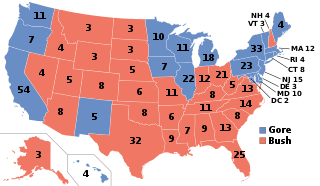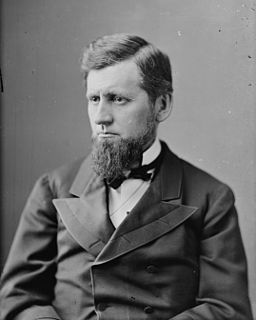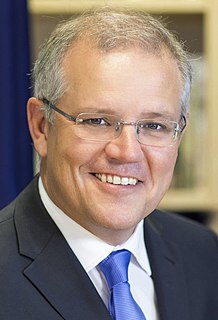
The Ohio Senate is the upper house of the Ohio General Assembly. The State Senate, which meets in the Ohio Statehouse in Columbus, first convened in 1803. Senators are elected for four year terms, staggered every two years such that half of the seats are contested at each election. Even numbered seats and odd numbered seats are contested in separate election years. The President of the Ohio Senate presides over the body when in session, and is currently Larry Obhof.

The Forty-ninth United States Congress was a meeting of the legislative branch of the United States federal government, consisting of the United States Senate and the United States House of Representatives. It met in Washington, D.C. from March 4, 1885, to March 4, 1887, during the first two years of Grover Cleveland's first presidency. The apportionment of seats in the House of Representatives was based on the Tenth Census of the United States in 1880. The Senate had a Republican majority, and the House had a Democratic majority.

The House of Assembly of Zimbabwe is currently the lower of two chambers in the Parliament of Zimbabwe. Between 1989 and 2005, when the Senate didn't exist, the House of Assembly was the only chamber, but it was one of two chambers from independence in 1980 until 1989 and has been so again since 2005.

Federal elections were held in Australia on 1 December 1984. All 148 seats in the House of Representatives and 46 of 76 seats in the Senate were up for election. The incumbent Labor Party led by Prime Minister Bob Hawke defeated the opposition Liberal–National coalition, led by Andrew Peacock.

The United States Senate elections of 1908 and 1909, some states elected their senators directly even before passage of the 17th Amendment in 1913. Oregon pioneered direct election and experimented with different measures over several years until it succeeded in 1907. Soon after, Nebraska followed suit and laid the foundation for other states to adopt measures reflecting the people's will. By 1912, as many as 29 states elected senators either as nominees of their party's primary or in conjunction with a general election. The Republicans lost two seats overall.

The 2000 United States elections were held on November 7, 2000.
The United States Senate elections of 1844 and 1845 were elections which, coinciding with James K. Polk's election, had the Democratic Party retake control of the United States Senate, gaining a net total of eleven seats from the Whigs.

The United States Senate elections of 1906 and 1907 were elections which had the Republican Party gain three seats in the United States Senate, expanding their majority to more twice that of the opposing Democratic Party.
The United States Senate elections of 1792 and 1793 were elections of United States Senators that coincided with President George Washington's unanimous re-election. In these elections, terms were up for the ten senators in class 2.
The United States Senate elections of 1836 and 1837 were elections that had the Jacksonian coalition emerge as the Democratic Party, and the Adams, or Anti-Jackson, coalition emerge as the Whig Party
The United States Senate elections of 1834 and 1835 were elections that had the Anti-Jackson coalition maintain control of the United States Senate. However, during the 24th Congress, the Jacksonian coalition gained control of the Senate.
The United States Senate elections of 1830 and 1831 were elections that had Jacksonians gain one seat in the United States Senate from the Anti-Jacksonian coalition, but lose one seat to the short-lived Nullifier Party. By the time Congress first met in December 1831, however, the Jacksonians had a net loss of one seat.
The United States Senate elections of 1864 and 1865 were elections corresponding with Abraham Lincoln's re-election, with the Republican Party gaining two seats in the United States Senate. As these elections occurred during the Civil War, most of the Southern States were absent.

The 2010 elections for the Oregon Legislative Assembly determined the composition of both houses for the 76th Oregon Legislative Assembly. The Republican and Democratic primary elections were on May 18, 2010, and the general election was held on November 2, 2010. Sixteen of the Oregon State Senate's thirty seats were up for election, as were all 60 seats of the Oregon House of Representatives.
The United States Senate elections of 1822 and 1823 were elections for the United States Senate that had the Democratic-Republican Party continue almost complete control of the Senate.
The 1834 United States elections occurred in the middle of Democratic President Andrew Jackson's second term. Members of the 24th United States Congress were chosen in this election. Taking place during the Second Party System, elections were contested between Andrew Jackson's Democratic Party and opponents of Jackson, including the remnants of the National Republican Party. During this election, the anti-Jackson faction began to transition into the Whig Party. Arkansas and Michigan joined the union during the 24th Congress. Democrats retained the majority in the House, and won control of the Senate.

The California state elections, June 2016 were held on June 7, 2016 and included one propositions, primary elections for each party's nominee for President, and primary elections to determine the top-two candidates for California's Class III seat to the United States Senate, all of California's seats to the House of Representatives, all of the seats of the State Assembly, and all odd-numbered seats of the State Senate, who will compete against each other in a run-off on November 8, 2016.

The 2019 Australian federal election will elect members of the 46th Parliament of Australia. The election will be called following the dissolution or expiry of the 45th Parliament as elected at the 2016 double dissolution federal election.

The Iowa general elections, 2016 will be held in the U.S. state of Iowa on November 8, 2016. One of Iowa's U.S. Senate seats and all four seats in the United States House of Representatives are up for election, as well as half of the Iowa Senate seats and all of the Iowa House of Representatives seats. Primary elections were held on June 7, 2016.
The 2018 Georgia State Senate elections are taking place as part of the biennial United States elections. Georgia voters will elect state senators in all 56 of the state senate's districts. State senators serve two-year terms in the Georgia State Senate.












